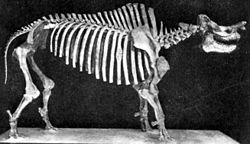Megacerops
|
Megacerops Temporal range: Late Eocene 38–33.9 Ma |
|
|---|---|
 |
|
| Mounted skeleton, AMNH | |
| Scientific classification | |
| Kingdom: | Animalia |
| Phylum: | Chordata |
| Class: | Mammalia |
| Order: | Perissodactyla |
| Family: | †Brontotheriidae |
| Genus: |
†Megacerops Leidy, 1870 |
| Species | |
|
|
| Synonyms | |
|
|
Megacerops ("large-horned face", from "large" + "horn" + "face") is an extinct genus of the prehistoric odd-toed ungulate (hoofed mammal) family Brontotheriidae, an extinct group of rhinoceros-like browsers related to horses. It was endemic to North America during the Late Eocene epoch (38–33.9 mya), existing for approximately 4.1 million years.
All of the species had a pair of blunt horns on their snout (the size varying between species), with the horns of males being much larger than those of the females. This could indicate that they were social animals which butted heads for breeding privileges.
Despite resembling the rhinoceros, it was larger than any living rhinoceros: the living animal easily approached the size of the African forest elephant, the third largest land animal today. It stood about 2.5 m (8.2 ft) tall at the shoulders and the body, including the head, could measure 5 m (16 ft) in length. It resembled a large rhinoceros, possessing a Y-shaped horn-like protrusion on its nose, with blunt ends. One specimen is estimated to have weighed 3.3 t (3.6 short tons) by Gregory S. Paul.
The dorsal vertebrae above the shoulders had extra long spines to support the huge neck muscles needed to carry the heavy skull. Possibly, it had fleshy lips and a long tongue, perfect for carefully selecting food. The shape of its teeth suggests that it preferred food such as soft stems and leaves, rather than tough vegetation.
The skeleton of an adult male was found with partially healed rib fractures, which supports the theory that males used their 'horns' to fight each other. No creature living in Megacerops' time and area except another Megacerops could have inflicted such an injury. The breathing movements prevented the fractures from completely healing. The adults may have also used their horns to defend themselves and their calves from predators, such as hyaenodonts, Bathornis or nimravids.
...
Wikipedia
